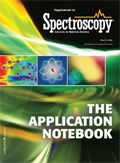Improved Performance and Functionality in UV-Visible Measurements

Enhancing Trace Element Analysis with Inductively Coupled Plasma Mass Spectrometry
May 15th 2025Elemental analysis is crucial in a wide variety of applications from detecting toxic elements within the environment, to ensuring drinking water is safe for human consumption, to food product safety. ICP-MS—able to measure an atom’s mass—offers low detection limits in the range of parts per trillion (ppt), making it a widely used method that can detect toxic elements well below regulatory limits. This paper expands upon how new ICP-MS technology can meet the challenges associated with heightened demands for element analysis and the hurdles laboratories face when analyzing high-matrix samples.
Real-Time Health Monitoring Using Smart Wearable Spectroscopy Sensors With AI
May 6th 2025A newly published review in the journal Advanced Materials explores how intelligent wearable sensors, powered by smart materials and machine learning, are changing healthcare into a decentralized, personalized, and predictive modeling system. An international team of researchers highlights emerging technologies that promise earlier diagnosis, improved therapy, and continuous health monitoring—anytime, anywhere.
AI and Satellite Spectroscopy Team Up to Monitor Urban River Pollution in China
April 30th 2025A study from Chinese researchers demonstrates how combining satellite imagery, land use data, and machine learning can improve pollution monitoring in fast-changing urban rivers. The study focuses on non-optically active pollutants in the Weihe River Basin and showcases promising results for remote, data-driven water quality assessments.
How Satellite-Based Spectroscopy is Transforming Inland Water Quality Monitoring
Published: April 29th 2025 | Updated: April 29th 2025New research highlights how remote satellite sensing technologies are changing the way scientists monitor inland water quality, offering powerful tools for tracking pollutants, analyzing ecological health, and supporting environmental policies across the globe.

.png&w=3840&q=75)

.png&w=3840&q=75)



.png&w=3840&q=75)



.png&w=3840&q=75)